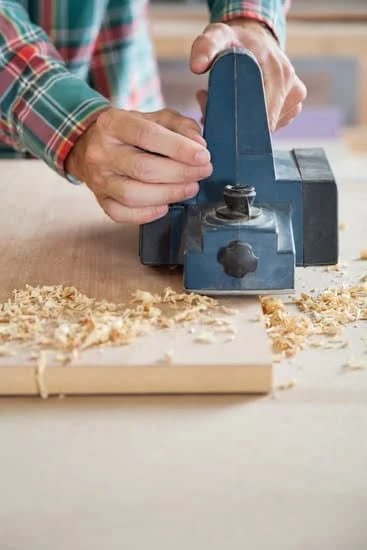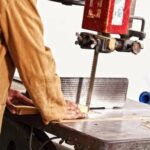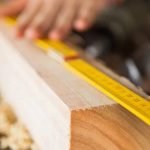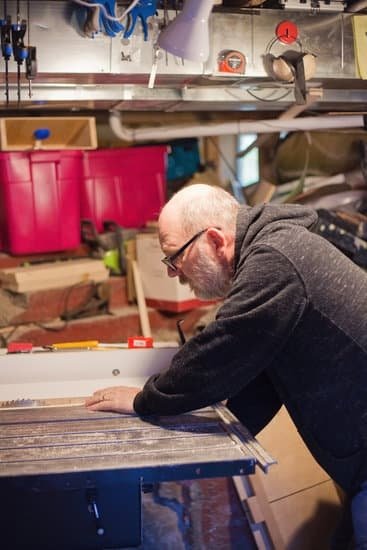Woodworking is a craft that requires precision and attention to detail, and the quality of the wood plays a crucial role in the final outcome. One of the key factors that directly impacts the success of any woodworking project is the moisture content of the wood. Understanding how to properly dry wood is essential for achieving stability, durability, and overall high-quality results in woodworking endeavors.
When it comes to woodworking, using properly dried wood is of paramount importance. Wood with high moisture content can lead to numerous issues such as warping, splitting, and shrinking after it has been crafted into a finished product. These defects not only compromise the aesthetics of the piece but also affect its structural integrity.
The process of drying wood involves removing moisture from within its fibers. By reducing the moisture content to an appropriate level, wood becomes more stable and less susceptible to changes caused by temperature and humidity fluctuations. It also becomes easier to work with, allowing for better joinery techniques and finishes.
Whether you are a novice woodworker or have years of experience in the craft, understanding how moisture affects wood and knowing different drying methods is essential. In this article, we will explore various approaches to drying wood for woodworking projects.
From traditional methods like air drying and kiln drying to alternative techniques such as oven drying, we will discuss their pros and cons, step-by-step guides, safety considerations, and tips for success. By gaining knowledge about these different methods, you can make informed decisions about which approach suits your project best for achieving optimal results in your woodworking ventures.
The Traditional Methods of Drying Wood for Woodworking
The traditional methods of drying wood for woodworking include air drying and kiln drying. Each method has its pros and cons, and understanding them can help woodworkers make an informed decision based on their specific needs and resources.
Air drying is the oldest and simplest method of drying wood. It involves stacking the wood in a well-ventilated area and allowing it to dry naturally over time. One advantage of air drying is that it is a low-cost option, as it requires minimal equipment.
However, air drying can be a slow process, often taking months or even years depending on the type of wood and climate conditions. The factors that affect the air drying process include temperature, humidity, airflow, and the initial moisture content of the wood.
On the other hand, kiln drying offers a faster and more controlled approach to wood drying. Kilns are specially designed chambers that use heat and controlled humidity levels to accelerate the drying process. This method allows for more precise control over moisture content and reduces the risk of defects such as warping or cracking.
Additionally, kiln-dried wood is generally more stable than air-dried wood. However, kiln drying requires specialized equipment, which can be costly for individual woodworkers. It also consumes energy due to heating requirements.
In summary, both air drying and kiln drying have their advantages and disadvantages in terms of cost, time required, and overall quality of the dried wood. Woodworkers should carefully consider their specific needs and resources before deciding which method to use for their projects.
The Oven Drying Technique for Woodworking
The oven drying technique for woodworking offers an alternative method to traditional wood drying methods such as air drying and kiln drying. While it may not be the most commonly used method, it can be effective under certain circumstances. Before attempting to dry wood in the oven, there are several factors to consider.
One important factor to consider is the type of wood being dried. Not all types of wood are suitable for oven drying. Softwoods like pine or fir tend to dry more evenly and predictably in an oven compared to hardwoods like oak or maple. Additionally, the thickness of the wood plays a role in determining if it can be successfully dried in an oven. Thinner pieces of wood tend to dry more uniformly and without warping compared to thicker pieces.
Before starting the oven drying process, it is crucial to prepare the wood properly. This includes ensuring that the moisture content of the wood is within a suitable range for drying. Ideally, the moisture content should be around 6-8% for most woodworking projects. Using a moisture meter can help accurately determine the moisture content of the wood before placing it in the oven.
Once the wood is properly prepared, setting up the oven for optimal drying conditions is essential. It is recommended to set the oven temperature between 200-250 degrees Fahrenheit (93-121 degrees Celsius) and leave enough space between each piece of wood for proper airflow. Placing a fan nearby can also help improve air circulation inside the oven.
During the drying process, it is important to monitor and control both temperature and humidity levels within the oven. Fluctuations in temperature or high levels of humidity can lead to uneven drying or even damage to the wood. Regularly checking on the progress and making necessary adjustments will ensure optimal results.
Oven drying has its advantages, such as faster drying times compared to air drying and more control over environmental conditions compared to kiln drying. However, there are also potential drawbacks and risks associated with oven drying. These include the risk of fire if the wood is exposed to high temperatures for too long or if flammable substances are present. It is important to take necessary safety precautions and follow proper oven drying techniques to minimize these risks.
The Oven Drying Process
The oven drying process is a viable alternative for drying wood for woodworking projects. While traditional methods like air drying and kiln drying are commonly used, the oven drying technique offers convenience and efficiency. This section will provide a step-by-step guide to help woodworkers successfully dry wood in the oven.
1. Preparing the wood for oven drying:
Before starting the oven drying process, it is essential to ensure that the wood has an appropriate moisture content. Wood with a high moisture content may not dry properly or may experience warping and cracking during the process. Use a moisture meter to measure the moisture content of the wood before placing it in the oven.
2. Setting up the oven for optimal drying conditions:
Preheat your oven to a temperature between 215-225°F (102-107°C). It is important to maintain this temperature throughout the drying process to prevent damage to the wood. Place a digital hygrometer inside the oven to monitor humidity levels. Ideally, you should aim for a humidity level between 25-30% during the initial stages of drying.
3. Monitoring and controlling temperature and humidity levels:
Once you have placed your wood in the preheated oven, check its progress regularly. Keep an eye on both temperature and humidity levels inside the oven using appropriate measuring tools. If necessary, make adjustments to maintain consistent conditions.
| Step | Description |
|---|---|
| Preparing the wood for oven drying | Ensure proper moisture content with a moisture meter |
| Setting up the oven for optimal drying conditions | Preheat oven to 215-225°F (102-107°C), monitor humidity levels with a hygrometer |
| Monitoring and controlling temperature and humidity levels | Regularly check progress, adjust conditions if necessary |
It is important to note that oven drying may not be suitable for all types of wood. Certain wood species may be prone to damage or may not respond well to this method. It is recommended to research and consult woodworking resources or experts to determine the suitability of oven drying for specific wood types. Additionally, it is advisable to start with smaller pieces of wood when experimenting with oven drying before attempting larger projects.
Overall, the oven drying technique offers woodworkers a convenient and efficient way to dry wood for their projects. By following the step-by-step guide provided in this section, woodworkers can expect reliable results and achieve the desired moisture content for their woodworking endeavors. However, it is crucial to weigh the pros and cons of oven drying in comparison to other methods before making a final decision on which technique to use.
Pros and Cons of Oven Drying for Woodworking
The process of drying wood for woodworking projects is crucial in ensuring the stability and quality of the final product. While traditional methods like air drying and kiln drying are commonly used, oven drying has emerged as an alternative technique. This section will discuss the pros and cons of oven drying for woodworking.
One of the main advantages of using the oven drying technique is its speed. Oven drying can significantly reduce the time required to dry wood compared to traditional methods. Depending on the type and thickness of the wood, oven drying can take anywhere from a few hours to a few days, whereas air drying can often take months or even years. This makes oven drying particularly useful when working with time-sensitive projects or when a quick turnaround is desired.
Another advantage of oven drying is that it allows for more control over the drying conditions. With an oven, you have the ability to monitor and adjust the temperature and humidity levels, ensuring optimal conditions for drying the wood. This precision can be especially beneficial when working with specific types of wood that require specific moisture levels for ideal results.
However, there are also some drawbacks and potential risks associated with using the oven drying technique. One major concern is the potential for fire hazards. Wood that is dried at high temperatures in an enclosed space like an oven has an increased risk of igniting if not properly monitored. It is essential to follow safety precautions and never leave the oven unattended during the drying process.
Furthermore, certain wood species may not be suitable for oven drying due to their susceptibility to cracking or warping under high heat. It is important to consider these factors before attempting to dry wood in an oven.
Overall, while oven drying offers benefits such as speed and control over drying conditions, it also presents potential risks such as fire hazards and limitations with certain wood species. Woodworkers should carefully evaluate their project‘s requirements and consider these pros and cons before deciding whether or not to use this method for wood drying.
| Pros of Oven Drying for Woodworking | Cons of Oven Drying for Woodworking |
|---|---|
| – Speeds up the drying process compared to traditional methods | – Increased risk of fire hazards if not properly monitored |
| – Allows for control over temperature and humidity levels | – Certain wood species may not be suitable for oven drying due to cracking or warping |
Safety Considerations and Precautions
Fire risks and how to mitigate them
When drying wood in the oven for woodworking, it is important to be aware of the potential fire risks involved. Wood that is not properly dried or has a high moisture content can easily ignite when exposed to high temperatures. To mitigate this risk, it is crucial to follow safety precautions and guidelines.
One way to minimize the risk of fire is by ensuring that the wood being dried is not in contact with any flammable materials or substances such as oils, solvents, or rags. These items can increase the chances of combustion and should be kept away from the oven at all times.
Additionally, it is recommended to regularly check the oven for any signs of smoke or excessive heat buildup. If there are any indications of smoke or overheating, immediately turn off the oven and remove the wood to prevent a potential fire hazard.
Protective measures to ensure personal safety while oven drying wood
While handling wood in the oven for drying purposes, it is essential to prioritize personal safety. Here are some protective measures that should be taken:
- Use proper protective gear: Wear heat-resistant gloves and safety goggles to protect your hands and eyes from potential burns or injuries.
- Adequate ventilation: Ensure that there is enough airflow in your workspace by opening windows or using fans, especially if you are working with toxic woods that produce harmful fumes.
- Fire extinguisher: Keep a fire extinguisher nearby and make sure you know how to use it effectively in case of an emergency.
- Monitoring equipment: Utilize temperature gauges and humidity meters to constantly monitor the conditions inside the oven and make necessary adjustments as needed.
Taking these safety measures will help prevent accidents and maintain a safe working environment while drying wood in your oven.
Safety considerations are paramount when utilizing alternative methods like drying wood in an oven for woodworking. By being aware of fire risks and taking appropriate precautions, woodworkers can minimize potential hazards and create a safe working environment. It is important to prioritize personal safety by using protective gear, ensuring proper ventilation, and having necessary safety equipment readily available. By incorporating these safety measures, woodworkers can safely experiment with oven drying while achieving desired results in their woodworking projects.
Tips and Tricks for Successful Oven Drying
Oven drying wood for woodworking can be a convenient and effective method if done correctly. Here are some tips and tricks to ensure successful oven drying:
- Use a moisture meter: Before placing the wood in the oven, it is important to measure its moisture content. A moisture meter will help you determine if the wood is ready for drying or if it needs further air drying. This will prevent issues such as cracking or warping during oven drying.
- Cut the wood into smaller pieces: To speed up the drying process, cut the wood into smaller pieces. This increases the surface area of the wood exposed to heat and airflow, allowing for faster evaporation of moisture.
- Preheat the oven: It is crucial to preheat the oven to the correct temperature before placing the wood inside. This ensures that the wood starts drying immediately without losing too much moisture in an unheated environment.
- Ventilation: Proper ventilation is key to successful oven drying. Make sure there is sufficient airflow inside the oven by leaving gaps between the pieces of wood or using a wire rack instead of a solid baking sheet. This allows hot air to circulate around each piece of wood evenly.
- Monitor temperature and humidity: Regularly monitor and control both temperature and humidity levels during oven drying. Use a thermometer to check that the oven maintains a steady temperature within your desired range, usually between 170°F (77°C) and 220°F (104°C), depending on your specific needs.
- Gradual increase in temperature: When starting the oven drying process, gradually increase the temperature instead of setting it at maximum right away. This helps minimize stress on the wood fibers, reducing the chances of cracking or warping.
It is worth noting that while these tips can contribute to successful oven drying, it is still important to follow safety considerations and precautions outlined earlier in this article to ensure both personal safety and prevention of fire risks. Additionally, it is recommended to consult with experts or experienced woodworkers for further guidance on oven drying techniques specific to your woodworking project.
Alternative Methods for Drying Wood for Woodworking
Exploring Other Drying Techniques
While oven drying can be a viable option for drying wood for woodworking projects, there are several alternative methods that craftsmen can consider. These methods offer different advantages and disadvantages and may be more suitable depending on various factors such as the type of wood, desired drying time, and available resources. Let’s take a closer look at two popular alternative methods: using dehumidifiers and utilizing microwaves.
Using Dehumidifiers
One alternative method for drying wood is to use dehumidifiers. Dehumidifiers work by removing excess moisture from the air, which helps accelerate the drying process. This method is particularly effective in areas with high humidity levels or during seasons when air drying may not be practical.
To use this method, first, seal the wood in an airtight container or wrap it tightly with plastic sheets to create a controlled environment. Then, place the dehumidifier near the wood to reduce the humidity within the container. It’s important to regularly check and adjust the settings on the dehumidifier to maintain optimal moisture levels throughout the drying process.
While using dehumidifiers can speed up the drying process compared to air drying alone, it is crucial to monitor moisture content regularly to avoid over-drying or under-drying. Additionally, dehumidifiers consume electricity and may increase energy costs, so budget considerations should also be taken into account.
Utilizing Microwaves
Another alternative method for drying small pieces of wood quickly is utilizing microwaves. Microwaving wood can significantly reduce drying time compared to conventional methods like air or kiln drying. However, this technique is best suited for small projects as large pieces may not fit inside microwave ovens.
To dry wood using a microwave oven, start by placing small pieces of wood in a microwave-safe container with a small amount of water. The water helps prevent the wood from overheating and combusting during the drying process. Microwave the wood in short bursts, ensuring to periodically check the moisture content until it reaches the desired level.
It is important to note that microwaving wood can lead to internal stresses or uneven drying, which may affect its stability and quality. Therefore, this method should be used with caution and primarily for small woodworking projects or when speedy drying is required.
By considering alternative methods such as using dehumidifiers or microwaves, woodworkers can have more flexibility in choosing the most suitable drying technique for their specific needs. However, it’s essential to carefully evaluate each method’s pros and cons before deciding on an approach.
Conclusion
In conclusion, the process of drying wood for woodworking is vital to ensure the stability and quality of the final product. Throughout this article, we have explored various methods of wood drying, including air drying, kiln drying, and oven drying.
While traditional methods like air drying and kiln drying have their benefits and drawbacks, the option of oven drying provides an alternative technique that may be suitable for certain woodworking projects. It is important to consider a few factors before attempting to dry wood in the oven, such as the type of wood being used and its moisture content.
When using the oven drying technique, proper precautions must be taken to ensure safety and minimize risks. Fire hazards should be mitigated by closely monitoring temperature levels and utilizing protective measures. Additionally, maximizing efficiency during the oven drying process can help achieve optimal results.
However, it is important to weigh the pros and cons of each method before making a decision on how to dry wood for woodworking. Alternative techniques such as using dehumidifiers or microwaves may also be worth exploring. In making an informed decision, it is essential to consider the specific needs of your woodworking project and desired results.
Ultimately, whether it’s through traditional methods or alternative techniques like oven drying, properly dried wood will greatly enhance your woodworking projects by ensuring durability and stability. By considering all available options and taking necessary precautions, you can choose a wood drying method that best suits your needs and achieves excellent results in your future woodworking endeavors.
Frequently Asked Questions
What is the fastest way to dry wood for woodworking?
The fastest way to dry wood for woodworking is by using a kiln. Kiln drying involves placing the wood inside a large chamber where temperature and humidity levels are carefully controlled.
This allows for a faster removal of moisture from the wood, significantly reducing drying time compared to traditional air drying methods. Kiln-dried wood is often preferred by woodworkers as it ensures a more stable and consistent final product, minimizing the risk of warping or cracking.
Is it safe to bake wood in the oven?
It is generally not safe to bake wood in a standard oven that is used for cooking food. Most household ovens are designed specifically for culinary purposes and may not be suitable or safe for heating wood. Baking wood in an oven can release harmful fumes or pose fire hazards if not done correctly.
Additionally, the high temperatures required for baking can potentially damage or warp the oven itself. It is always recommended to use appropriate equipment specifically designed for wood drying or seek professional services that specialize in kiln drying.
What is the oven dry method for wood?
The oven dry method for wood involves using an oven to remove moisture from the wood at a controlled temperature without the risk of damaging it. This method requires placing the wooden object or sample inside an oven set to a low temperature, usually between 180°F (82°C) and 220°F (104°C).
The goal is to gradually heat the wood and evaporate moisture over several hours or even days, depending on the thickness and type of wood.

Hi everyone! I’m a woodworker and blogger, and this is my woodworking blog. In my blog, I share tips and tricks for woodworkers of all skill levels, as well as project ideas that you can try yourself.





